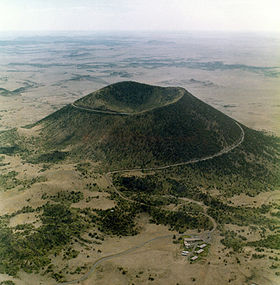Capulin Volcano National Monument
| Capulin Volcano | |
| National Monument | |
|
Last erupted between 58,000 to 62,000 years ago
|
|
| Country | |
|---|---|
| State | |
| Region | Union County, New Mexico |
| District | Raton-Clayton Volcanic Field |
| Elevation | 2,494 m (8,182 ft) |
| Coordinates | 36°46′56″N 103°58′12″W / 36.78222°N 103.97000°WCoordinates: 36°46′56″N 103°58′12″W / 36.78222°N 103.97000°W |
| Area | 793 acres (321 ha) |
| Geology | Cinder cone volcano |
| Founded | U.S. National Monument |
| Date | August 9, 1916 |
| Management | National Park Service |
| Visitation | 46,358 (2011) |
| Website: Capulin Volcano National Monument | |
Capulin Volcano National Monument is a U.S. National Monument located in northeastern New Mexico which protects and interprets an extinct cinder cone volcano that is part of the Raton-Clayton Volcanic Field. A paved road spirals around the volcano and visitors can drive up to a parking lot at the rim. Hiking trails circle the rim as well as lead down into the mouth of the volcano. The monument was designated on August 9, 1916 and is administered by the National Park Service.
The visitor center features exhibits about the volcano and the area's geology, natural and cultural history, and offers educational programs about volcanoes. There is also a video presentation about the volcano. The name capulin comes from a type of black cherry, Prunus serotina, that is native to southern North America.
From the National Park Service:
Capulin Volcano is one of the outstanding landmarks located in the northeast corner of New Mexico, where the rolling grasslands meet the foothills of the Sangre de Cristo Mountains. Capulin Volcano's highest point provides unobstructed, panoramic views of the volcanic field, distant snow-capped mountains, and portions of five states (New Mexico, Oklahoma, Kansas, Texas and Colorado).
Capulin Volcano also offers visitors excellent opportunities for observing and understanding volcanic formation. The large volcanic field surrounding the monument contains at least 100 recognizable volcanoes, and aids visitors in gaining insights into 10 million years of the geological history of northern New Mexico.
The grass-covered outer slope of the cinder cone.
A trail leads from the parking lot to the crater floor.
View from the summit.
Panorama view from the top.
A satellite image of the volcano (center) and the surrounding area
According to the National Park Service:
On January 16, 1891, Capulin Mountain was "…withdrawn from settlement, entry or other disposition under any of the public land laws, until such time as Congress may see fit to take action touching the same or until otherwise ordered by competent authority…"
...
Wikipedia


